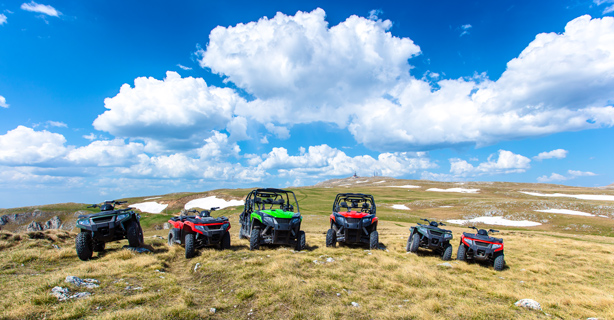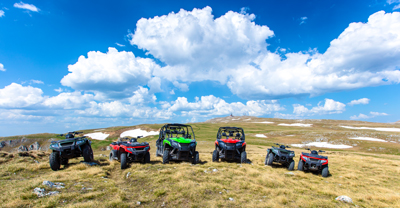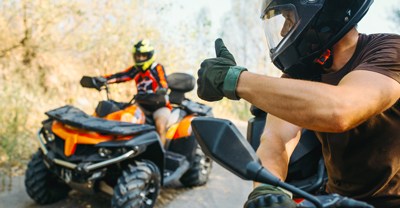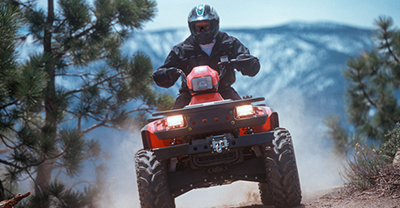Common types of ATVs and UTVs


0 min. read
Considering an off-road adventure? It's important to understand the different types of all-terrain vehicles (ATVs) and utility terrain vehicles (UTVs), each offering unique advantages for various terrains and purposes. As the off-road vehicle (ORV) market booms—experts predict 4.4% growth annually until 2033*—you can look forward to more trails to explore, more gear options to personalize your ride, and a whole lot more mud (or dust, depending on your terrain)!
This guide reviews the common types of ATVs and UTVs, highlighting their unique strengths and functionalities to help you make an informed decision for your next ORV.

What are ATVs?
ATVs are increasingly popular among riders with access to single-track roads and off-road trails. Common uses for ATVs include transportation and recreation, such as trail riding or racing.
While you can customize your ATV, these vehicles typically share the following three features:
Similar seating position (intended for a single rider)
Handlebar control
All-terrain capability (excluding water)
What are UTVs?
UTVs, also called side-by-sides (SXS), are often used for work rather than recreation. These large, powerful vehicles accommodate a passenger and generally offer ample storage space for transporting items. UTVs are ideal for moving equipment or supplies in areas where a truck isn't practical or possible.
For example, farmers often use UTVs to transport hay, feed, or other supplies. UTVs are also commonly used in construction and landscaping. Additionally, some riders purchase UTVs for recreational purposes, such as camping, hunting, or other outdoor activities.
Learn more: ATV vs. UTV: The differences explained
Comparing types of ATVs and UTVs
When considering an ATV or UTV, you have two primary options—sport or utility. You can also refine your search by looking for commercial, full-size, or mid-size options, depending on the desired number of passengers and applications.
The design of ATVs and UTVs depends on their uses, including hunting, recreation, farming, racing, military, emergency services, and more.
ATVs and UTVs can also be categorized by their size and power. For example, sport ATVs range from 50cc (for youths) up to 700cc. For utility ATVs, people generally invest in an 800cc to 1,000cc vehicle. For utility purposes, UTVs over 1,000cc are available, but these are powerful vehicles aren’t intended for beginners.
Sport ATVs
Sport ATVs are lightweight vehicles, typically going up to 700cc. They often feature excellent suspension systems for handling bumps, jumps, and tight turns. Numerous customization options exist to enhance the look and performance of sport ATVs.
If you plan to spend more time on trail riding or other recreational activities—as opposed to towing or hauling items—a sport ATV is probably the way to go.
Utility ATVs and UTVs
Utility ATVs and UTVs tend to be heavier. While they have less suspension, they feature bigger motors to enable more specialized work. Although these utility off-road vehicles are often designed for work-related purposes, they can also be used for recreation.
If you own a farm, run an outdoor business, or want to clear your property, a utility vehicle is your best bet for combining work and recreation.
Commercial ATVs and UTVs
If you’re looking for an off-road vehicle for commercial purposes, a UTV is often your best option, especially if you plan on towing or need a higher cargo capacity. UTVs provide greater stability, utility, and comfort than ATVs, which is why they are commonly used in farming, transportation, and construction.
That said, many commercial applications benefit from a mid-size ATV, especially when navigating tighter spaces and hauling lighter loads. Landscaping, mining, and refineries are all examples where mid-size commercial off-road vehicles are ideal.
Both mid-size and full-size commercial options offer industry-leading durability, as they are designed for work. For example, Polaris makes an entire line of commercial off-road vehicles.

Request a free off-road insurance quote today.
What size ATV/UTV is right for you?
A mid-size ATV or UTV is best for riders who want to combine light utility work with trail riding. This vehicle size offers more maneuverability, typically measuring 60–75 inches in length and 40–50 inches in width.
In contrast, full-size ATVs or UTVs offer maximum power and stability. These vehicles are often 75–90 inches long and 45–55 inches wide. Engine size is another important consideration.
Sizing matters for commercial purposes, so you'll want to consider variables such as safety features, maneuverability, durability, and serviceability.
Engine displacement in ATVs and UTVs
Engine displacement, measured in cubic centimeters (cc), determines an ATV or UTV's power and performance. When choosing an ATV or UTV, consider its intended use and your skill level. Here are some general guidelines but be sure to research and ask questions if you're uncertain about the best size for you or the person you're purchasing the off-road vehicle for.
For those 16 years and younger: 70–150cc is sufficient power. For kids 12 and younger, 50–70cc models are available. Always prioritize safety by providing appropriate protective gear. Make sure to verify that children under 16 are legally permitted to operate ORVs in your state.
For smaller adults or brand-new riders: Vehicles up to 300cc are ideal.
For inexperienced riders, light work, or easy trail riding: Opt for a 300–500cc vehicle.
For larger adults, heavy workloads, or intense trail riding: A 500–700cc vehicle is recommended, as long as you have the experience and skill to operate it.
For hill climbing, racing, or tackling deep mud: You don't need a 700–1000cc ATV or UTV unless you're experienced with difficult off-road challenges or are a professional racer.
Top ATV and UTV brands
When shopping for an ATV or UTV, consider these brands known for their reliability, performance, and power:
Polaris™ is one of the top off-road vehicle manufacturers in the world. Their vehicles are known for their style, features, and performance. Popular ATV models include the Scrambler and Sportsman. For UTVs, top models include the General, Ranger, and RZR.
Can-AM™ offers top-engineered handling, industry-leading performance, and eye-catching designs. Popular ATV models include the Outlander and the Renegade. For UTVs, consider the Maverick and the Commander.
Yamaha™ is known for its range of reliable, durable ATVs and UTVs, popular among racers, trail riders, hunters, and farmers. The Kodiak and the Grizzly are popular ATV models, and the Viking and the Wolverine are top UTVs.
Suzuki™ launched one of the world’s first four-wheeled ATV in 1983 and has remained a trusted name since. The KingQuad and the QuadSport are popular ATV models known for their ability to tackle both work and play scenarios.
Other common brands include Honda™, Kawasaki™, and Textron™. Each ATV and UTV brand has its advantages and disadvantages, especially when buying a used model.
Protect yourself with off-road insurance
Owning an ATV or UTV opens doors to exhilarating off-road experiences. But just like any adventure, preparation is key. Consider investing in off-road insurance to safeguard yourself and your investment.
Dairyland®—a brand of the Sentry Insurance Group—offers off-road insurance for ATVs, UTVs, and other powersports vehicles. In many states, you can even bundle your off-road policy with your existing auto or motorcycle insurance for additional convenience.
The general information in this blog is for informational or entertainment purposes only. View our blog disclaimer.
All product names, logos, brands, and trademarks are property of their respective owners. All company, product, and service names are for identification purposes only. Use of any of the foregoing does not imply endorsement.










